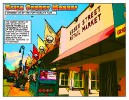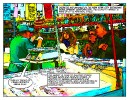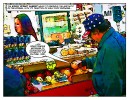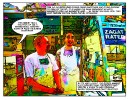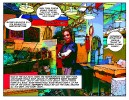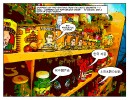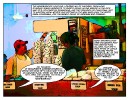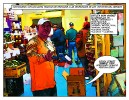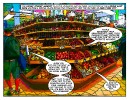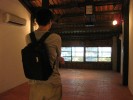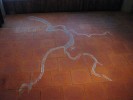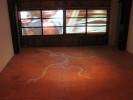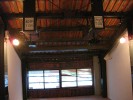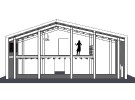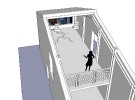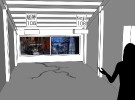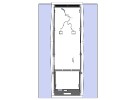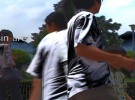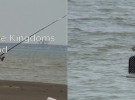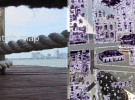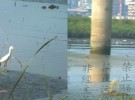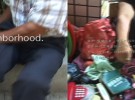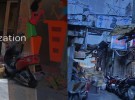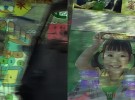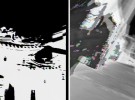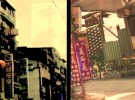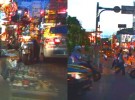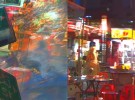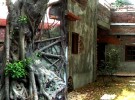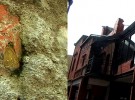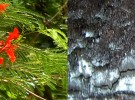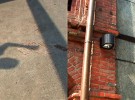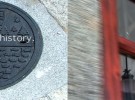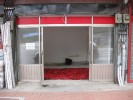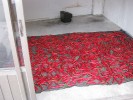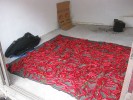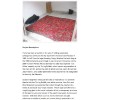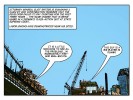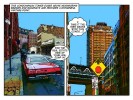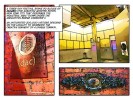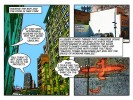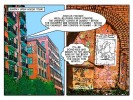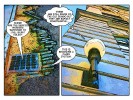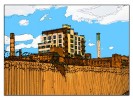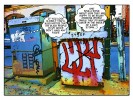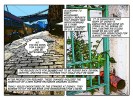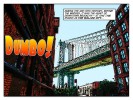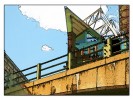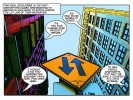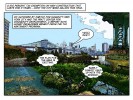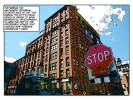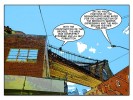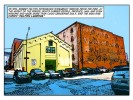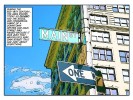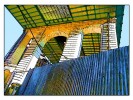Representation, a Chronicle of the Essex Street Market
Paul Clay, 2009
A series of 44″x66″ digital prints on archival 100% cotton paper, using historical research, oral history, and the representational form of a comic book, to chart the sociocultural development of the Lower East Side through the story of the Essex Street Market.
A selection of the pieces will be on display, starting with the opening reception Saturday, December 12th, from 5pm-7pm in the North End of the Essex Market, 120 Essex St., New York City, and the exhibit will run through January 2010.
This project is made possible, in part, with public funds from the Manhattan Community Arts Fund, supported by the New York City Department of Cultural Affairs and administered by the Lower Manhattan Cultural Council, and with generous support from The New York City Economic Development Corporation and the Department of Small Business Services.
Project Description:
The comics are made from photos of actual people who work in and frequent the market,and include text in multiple languages, with both historical data, and information from oral histories, capturing a snapshot of a vibrant and volatile historical moment.
The Essex Street Market is a long standing center of everyday culture in the Lower East Side. It is unique on many fronts: for the products available, the atmosphere of the place, its inherent support for rapidly disappearing craft practices, and its tradition of multi generational handing-down of family business lore. Also, by its very layout, it supports high job density and the preservation of the aesthetic of the bodega, with its tradition of daily food purchase and simultaneous exchange of neighborhood, community and cultural information. The Essex Street Market is a vital business and cultural institution in the Lower East Side and this artwork highlights its special place within the community and the culture of New York City.
The neighborhood contains a diverse mix of cultures, from long standing Jewish residents to Puerto Ricans having arrived in the 60’s and 70’s, followed by Dominicans, and the expansion of Chinatown, not to mention local artists who settled in the area back when the rents were affordable, and the recent influx of Japanese and Koreans. Rapid gentrification over the recent past has created huge cultural flux and a wide range of levels of income among residents.
A 90 minute two channel video art installation, involving video projection on paper covered windows in a 100 plus year old Chinese warehouse building, Chalk floor drawing, signage, and lighting.
Presented as part of “Fusion Folks – Contemporary Art Exhibition” Organized by the Taipei Department of Cultural Affairs and planned by Taiwanese independent curator Mr. Sean C.S. Hu. 24 artists both Taiwanese and international, create works related to the Bo-Pi-Liao Historic Center, in the Wanhua District, creating closer ties between art, history, and local customs. Taipei City, Taiwan, from 8/29/09 to 11/01/09.
Installation Photos:
3D Model of Installation:
Video stills of both Channels:
Video Documentation:
[tubepress video=”I5ZJ6oMCwF0″ embeddedWidth=”610″ embeddedHeight=”380″ length=”true”]
Project Description:
Mengjia-108, is a two channel video installation which explores the complex multicultural history of the Wanhua District, in Taipei City, a site of continuous human habitation along the Danshui River, for thousands of years. The title of the work refers to an ancient name for the area, along with the current postal code number. Â Wanhua’s long history and its contemporary status are thus juxtaposed in simultaneous existence. The work employs collage, video filter effects, and text overlay, to present images of past and present, as well as differing viewpoints, angles, and cultural perspectives.
Taiwan has been inhabited for perhaps tens of thousands of years, and the first people in the Taipei basin area arrived around 6000 years ago. These first peoples, or first nations, formed a robust river and seafaring culture. Both they and their language eventually spread all across the islands of South Asia and the Pacific, as far as New Zealand and even the land of the current United States of America. Due to lack of written records and in the absence of large scale architectural remains in long lasting materials, this monumental technological and cultural achievement has garnered little recognition.
Starting in the 1600’s successive waves of peoples including the Spanish, Dutch, Japanese and Han Chinese took control of all or parts of Taiwan, each leaving their mark on its cultural heritage. Throughout this history the Danshui River, and the Wanhua District area have played a major roll.
Wanhua has been an important harbor and trading site for thousands of years, and Mengjia-108 traces some of the disparate viewpoints and little known truths about the area. The Wanhua district has a proud and complex multicultural past, appreciation of which can serve as a guide to the shaping of its future.
Sun Dried Boys (Red Pepper Found Installation), Paul Clay, 2009
Presented in conjunction with (but not associated with), the 2009 Incheon Women Artists Biennale, Incheon Korea.
Multimedia work. Text description, digital photos of storefront installation with red paper-covered windows, television set, red plastic wash basin, flattened cardboard box, two black nets, drying red peppers. Dimensions variable.
Project Description:
Sun Dried Boys starts with a “found installation” or readymade in the form of something already existing, that looks for all the world like an art installation.
The space is photographed and then explicated at length, putting the “installation” in context within the contemporary art scene. The actual artwork consists of the photographs and the text in the form of a fictional “Project Description”. In one way such a work could simply be read as prankster art, but the real intent is to use the found space as a lens to view the art context of which the installation is supposedly a part.
Sun Dried Boys thus explores the social network around the 2009 Incheon Women Artists Biennale, acknowledges folk art and undervalued women’s practices, rips-off or riffs-on, the exploration of other artists work during the exhibit, and acknowledges the gendered power structures that still exist in society and in the contemporary art scene.
The artwork can be viewed at the following url:
http://sundriedboys.blogspot.com/
Two works from this series appeared in the group exhibit, “Anthropology: Revisited, Reinvented, Reinterpreted”, at Central Booking, Brooklyn, NY, November 2009. The work is intended to explore the Brooklyn neighborhood of Dumbo, and is available in two forms:
As individual 44″ x 66″, or 22″ x 33″ prints, archival ink, on acid free 100 percent cotton paper.
As individual images without text in the form of 38″ x 54″ archival ink prints on canvas.
Project Description:
Dumbo Comic (Print Work) takes 30 Washington Street as its starting point, to explore Dumbo’s unique history, and its architectural and sociological development. The artworks, in the form of comics, take inspiration from the factories built along the East River waterfront, and from Robert Gair’s position in the end of the 19th century as an inventor involved in industrial printing, cardboard box manufacturing, and real estate.
The work includes reference to the idea of the “Walled City”, a nickname for Brooklyn in the time before the bridges, when there were so many warehouses along the river that it created the look of a walled fortress from the water side. The name can also be interpreted as a reference to the subsequent isolation that Dumbo suffered from, following the construction of the bridges and the Brooklyn Queens Expressway. The bridges and expressway not only made it hard to pass directly into Dumbo from the rest of Brooklyn, but also, because of the length of the exit-ways off of the bridge actually made all the Brooklyn/Manhattan traffic bypass Dumbo, traveling several stories above it. This (at first) tragic walling off, ultimately helped to preserve many of the historic qualities of the neighborhood which are valued today.
Dumbo, New York City’s 90th historic district, is bounded by John Street to the north, York Street to the south, Main Street to the west and Bridge Street to the east, and includes 91 buildings that reflect its industrial heritage. The Brooklyn waterfront region was one of the premier industrial areas in the United States, and at the turn of the 20th century, Brooklyn was the fourth-largest manufacturing center in the country.
Dumbo Comic (Print Work) looks at the historical development of this area through the use of line drawing, and the comic. The line is a simple yet powerful visual tool. Greek legend has it that the first drawing originated from someone using a stick to copy shadows in the sand, and line drawing has long functioned to allow a kind of caricature, or portrait of a person or thing. Comics use a simplified, or iconic visual language to explain complex ideas and narrative structures – a kind of “amplification through simplification”. The form tends to be democratic in nature, and readily accessible to a broad spectrum of society.
The origins of the modern single frame political cartoon can be traced to Britain in the 1800’s and is distinguished by the use of caricature. Throughout much of the United States’ history, political cartoons have held a prominent place. In the Civil War era, Thomas Nast invented the “Donkey” and “Elephant” that remain today the standard signs for the Democratic and Republican parties. They help us focus on the metaphors used in societal discourses.
Comics (or multi-frame cartoons) developed in the late 19th and early 20th century, alongside the similar forms of film and animation. The history and development of comics is directly linked to the development of 19th century manufacturing, to newspapers, and to the re-invention of printing as a large-scale industrial process. Robert Gair was a part of this movement, and the development of serial frame comics was happening at exactly the same time he was building “Gairville” in what is now Dumbo. Further, Gair’s newly developed process of industrial printing on cardboard, and his industrial production system for cardboard boxes was likely inspired by newspaper industrialization. Gair’s former factory was located in Manhattan near the Puck building, an historic area in the development of industrial printing.
Dumbo is a place of outsized architecture. Everything is at the scale of elephants or super heroes. In addition to its rich history, it is currently the site of some of the most intense gentrification in New York City. In Dumbo Comic (Print Work) the neighborhood and the buildings themselves are characterized through the visual language of the comic book, in order to provoke thought on issues of urban planning, quality of life, and the visual impact of the street level built environment. The project acknowledges the scale of the area and the special place which architecture and development holds here.
Methods:
Dumbo Comic (Print Work) consists of two series of works with images starting from 12 megapixel digital stills shot on the streets of Dumbo. These images are then individually run through a variety of different types of desktop printing software and extensively reworked and elaborated, resulting in a set of “Technicolor” schemed cartoon prints, capturing architectural detail, and the street level build environment.
Text has been added by doing a Google search for the word “Dumbo” and culling bits of text and actual quotes from the search results. Part of the byproduct of this method is that elements of text treating the 1941 Walt Disney Animated feature by the same name also make their way into the work, serendipitously adding to critique of issues within the neighborhood.
Working with the form of the comic, this project attempts to provoke thought on issues of urban planing, quality of life, and visual impact of the street level built environment.
